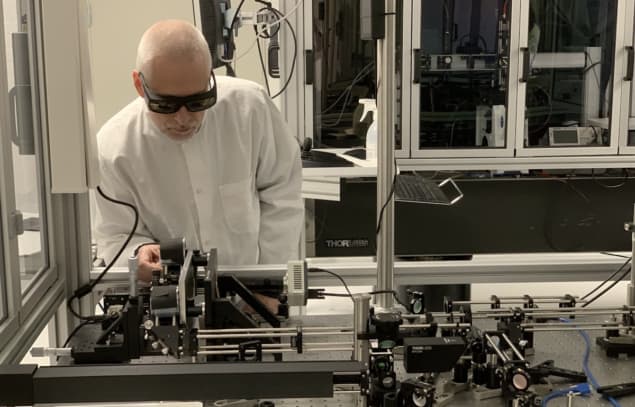
Optical coherence tomography (OCT) has emerged as a powerful diagnostic tool for capturing 2D and 3D morphological images at micron-scale resolution within biological tissue. The story so far is one of initial clinical acceptance – think game-changing applications of OCT in ophthalmology and retinal imaging – providing the platform for new streams of applied research, technology innovation and clinical translation across specialisms as diverse as dermatology, cardiology and oncology (for early-stage detection of cancerous lesions).
In terms of the fundamentals, OCT exploits the coherence of light backscattered from the sample microstructure, with interference effects allowing accurate determination of the spatial origin of the retrieved signals. There’s just one snag: the resolving capacity at depth. While cutting-edge OCT systems use near-infrared light to counter this problem, the inherent opacity and turbidity of biological tissue mean it’s often impossible to retrieve discernible optical signals (above the noise level) from depths beyond approximately 1 mm.
What consensus?
Meanwhile, the conventional wisdom among optical scientists is that the OCT signal is dominated by ballistically scattered light (light that has undergone a single backscattering event), whereas multiply scattered light and diffuse light are detrimental to image formation. Not so, argues a consensus-busting study published in Science Advances, in which researchers present an alternative viewpoint that selective collection of multiply scattered light can yield enhanced OCT image contrast at depth – and, in particular, for highly scattering samples.
“We have come up with a completely new way of doing OCT,” explains Peter Andersen, group leader in biophotonic imaging at DTU Health Tech, the department of health technology at the Technical University of Denmark (DTU) in Kongens Lyngby, north of Copenhagen. The approach, dubbed spatially offset OCT (SO-OCT), decouples the incident and collecting light paths, such that it’s possible to tune between the ballistically scattered and multiply scattered light components, respectively.
“It’s worth noting as well that our initial experiments are supported by wave-based modelling of the SO-OCT system,” adds Andersen, “and confirm that we can enhance contrast at depth by using multiply scattered light exclusively.”
The clinical imperative here is self-evident, with delineation at depth a key parameter in the staging of cancerous lesions – and, in turn, figuring out the appropriate course of treatment. “When the imaging contrast at depth is improved, it means the delineation of different tissues is similarly enhanced,” notes Andersen. “With SO-OCT, we have demonstrated that we can better identify tissue borders and the changing thickness of tissue layers at depth and, by extension, link all this back to the detection of disease.”
It’s all about translation
What’s more, clinical translation is already on the agenda for Andersen and colleagues. The current SO-OCT demonstrator, for example, is built as an add-on to a standard commercial instrument, while work is underway to integrate the laboratory set-up with fibre-optic probes, a precursor to endoscopy studies where the increased imaging depth will come into its own.

Multimodal optical imaging ready to shine in the early detection of colorectal cancer
“There is huge potential for SO-OCT technology to complement conventional OCT endoscopy applications and we aim to take the next steps as soon as possible,” concludes Andersen.
The research on SO-OCT is part of an ongoing collaboration between Andersen’s team at DTU Health Tech and Kishan Dholakia and colleagues at the University of Adelaide, Australia, and the University of St Andrews, Scotland – all working under the auspices of the European Union PROSCOPE project, which is exploiting innovative fibre-optic technologies in tandem with endoscopic delivery to diagnose colorectal cancer in its earliest stages.
- SEO Powered Content & PR Distribution. Get Amplified Today.
- PlatoData.Network Vertical Generative Ai. Empower Yourself. Access Here.
- PlatoAiStream. Web3 Intelligence. Knowledge Amplified. Access Here.
- PlatoESG. Automotive / EVs, Carbon, CleanTech, Energy, Environment, Solar, Waste Management. Access Here.
- PlatoHealth. Biotech and Clinical Trials Intelligence. Access Here.
- ChartPrime. Elevate your Trading Game with ChartPrime. Access Here.
- BlockOffsets. Modernizing Environmental Offset Ownership. Access Here.
- Source: https://physicsworld.com/a/spatially-offset-oct-counter-intuitive-scheme-delivers-high-contrast-imaging-at-depth/



